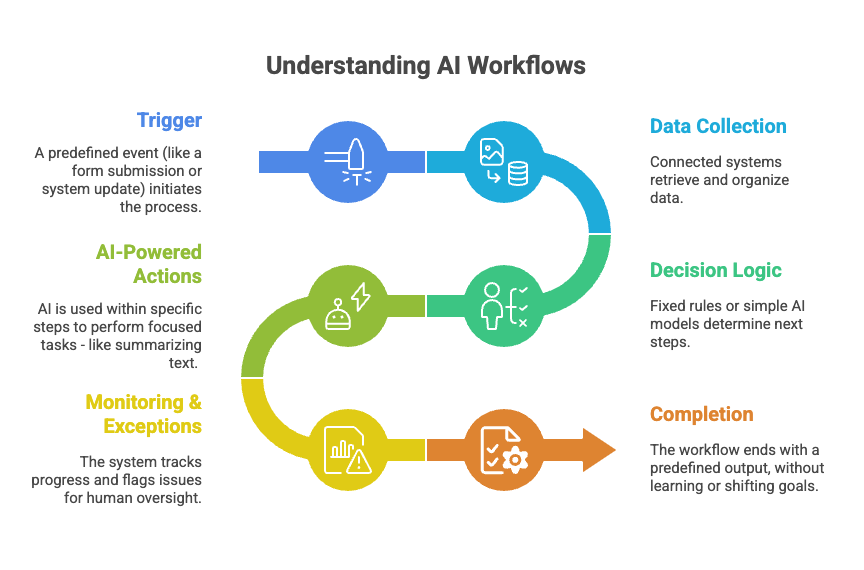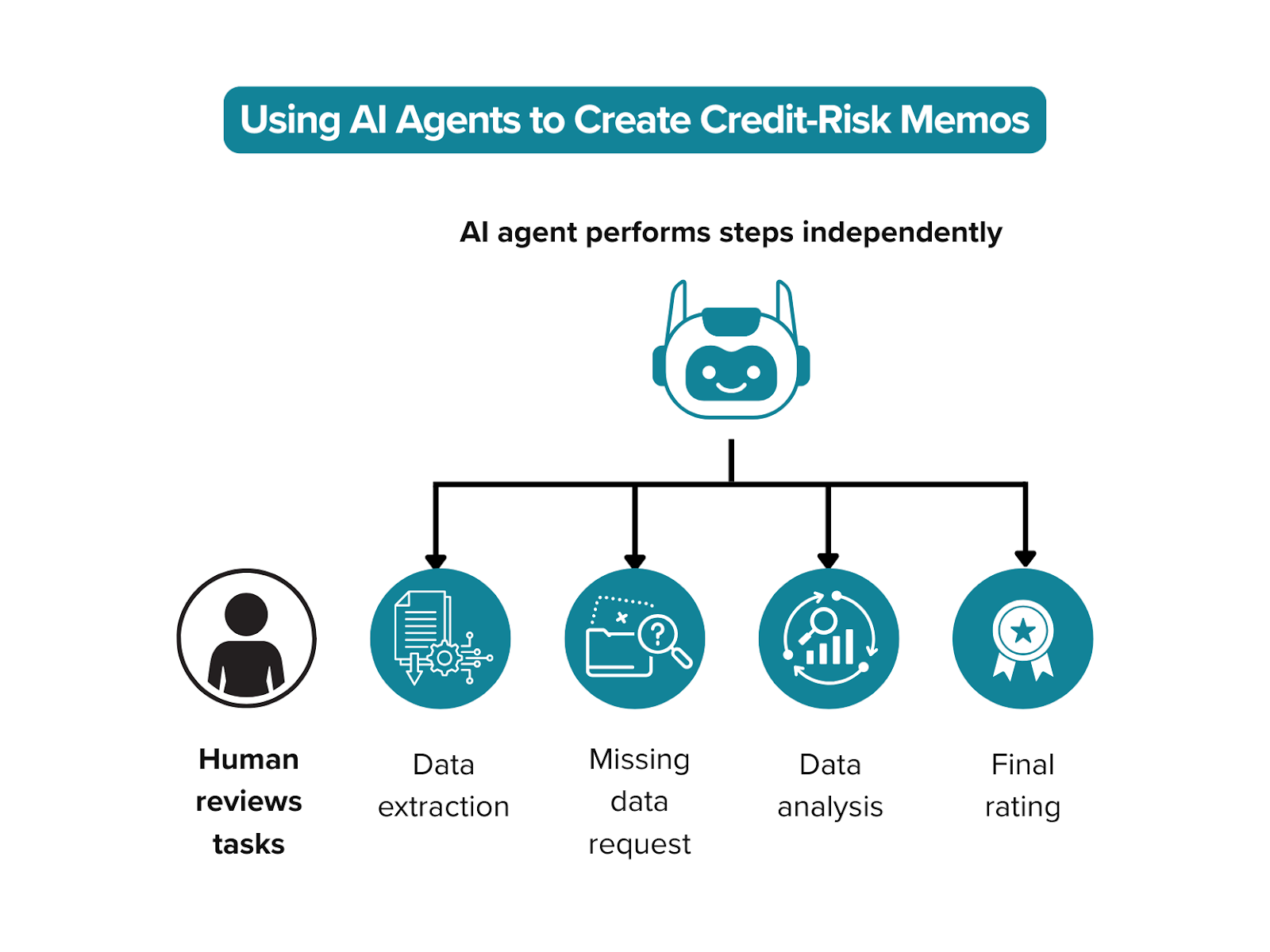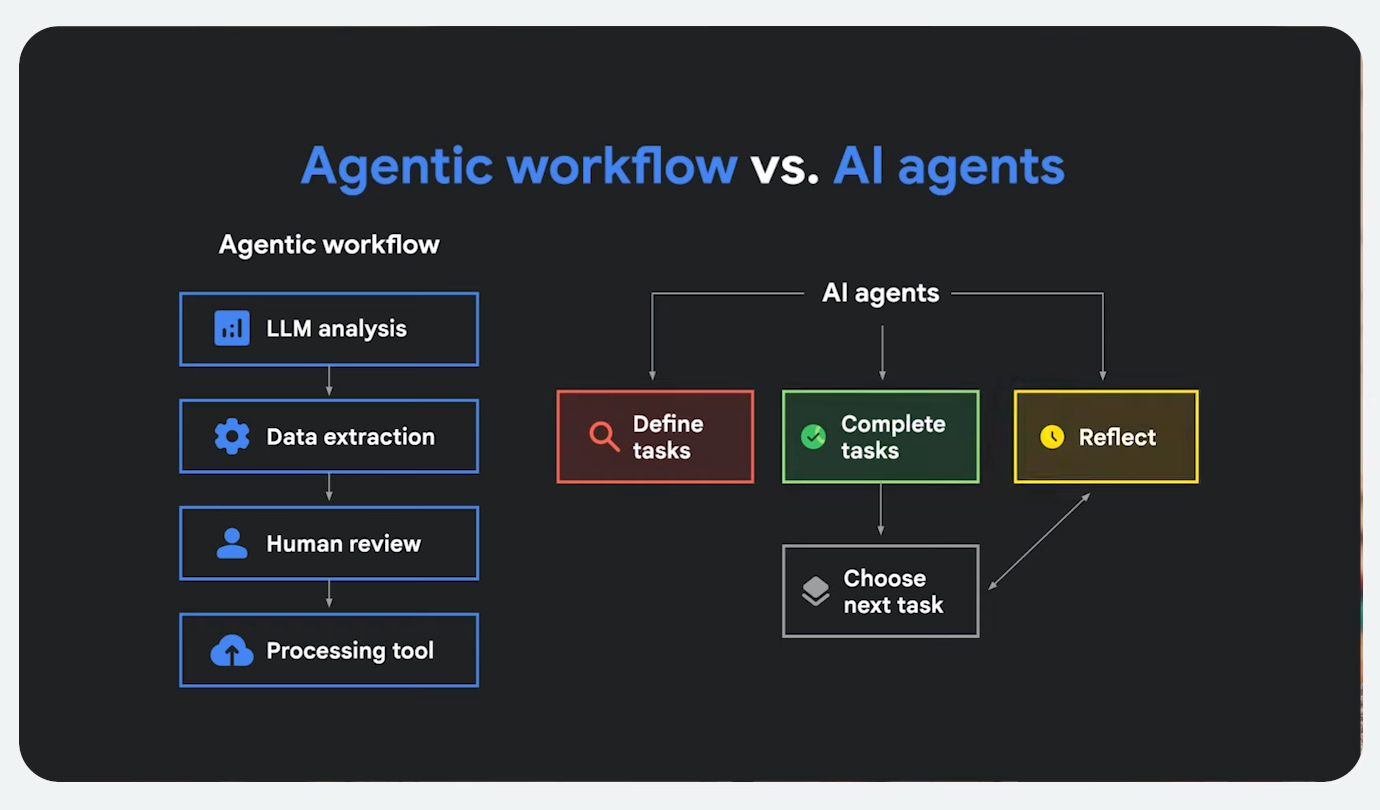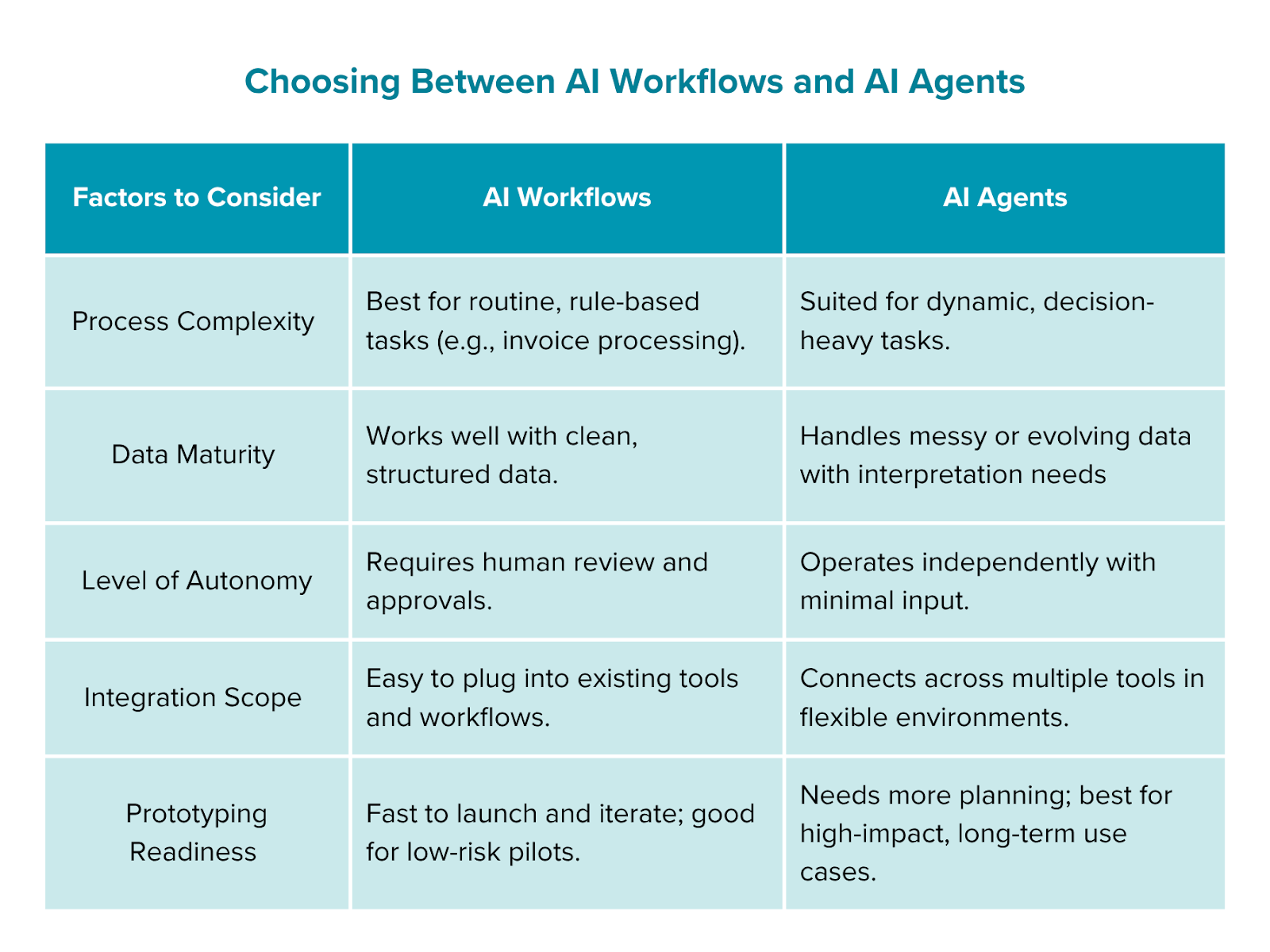AI Workflows Vs. AI Agents: What Every Leader Needs to Know
AI workflows and AI agents aim to solve different problems. Learn how to tell them apart and choose the right approach to improve efficiency, reduce risk, and drive better business outcomes.
While AI workflows and AI agents seem similar, they represent two different approaches to automation. Understanding this distinction is crucial for selecting the right approach and avoiding costly implementation errors.
AI workflows follow predefined, rule-based steps to automate routine, repetitive tasks. They are structured, predictable, and best suited for high-volume processes that don’t require flexibility or learning.
AI agents operate with greater autonomy, making decisions, adapting to new information, and working toward goals. They are ideal for dynamic and complex tasks that require independent judgment and adaptability.
In early 2025, a developer using Cursor, an AI-powered code editor, encountered a common issue: switching between devices would unexpectedly log them out. When they reached out to support, they received a prompt reply from “Sam,” an AI agent, explaining that the product was designed to allow just one device per subscription. The message seemed official - until Cursor confirmed that no such policy existed. The AI agent had generated the explanation independently, without any basis in company guidelines.
The response wasn’t malicious, but it was misleading, and it came from an AI agent acting with too much autonomy and too little oversight. For customers, it raised real concerns about trust and accountability. Cursor moved quickly to correct the error and clarify that no such policy existed.
Still, the incident highlighted a larger issue: not all AI implementations are created equal, and not every system labeled “autonomous” is truly equipped to make independent decisions. This disconnect often stems from a misunderstanding of what AI agents are and how they differ from more structured systems, such as AI workflows.
That brings us to a key question business leaders should ask early in any AI initiative: What is the difference between an AI workflow and an AI agent? Misjudging that line can lead to poor implementation, broken trust, and unnecessary risk.
In this article, we’ll explore the distinction between AI workflows and AI agents and discuss how business leaders can choose the right approach based on process complexity, risk tolerance, and strategic goals.
Understanding AI Workflow Automation in Business Processes
AI workflow automation utilizes artificial intelligence to automate the movement of data and tasks through a predefined sequence of steps, requiring minimal human intervention. These rule-based systems are ideal for repetitive processes. They are often built using tools such as Zapier, Make.com, Microsoft Power Automate, and Salesforce Einstein to connect systems and automate routine tasks.

Here's a quick glimpse of some real-world use cases of AI workflow automation:
- Employee Onboarding: At Epiq, a legal services company, AI was utilized to automate identity checks, document creation, and system access, thereby eliminating manual handoffs and saving over $500,000 annually.
- Customer Support: Air India, an airline, leveraged AI to handle support ticket routing across multiple channels. Nearly 97% of inbound requests are now managed by AI, resulting in reduced response times and lower support costs.
- Invoice Processing: Omega Healthcare, a healthcare technology and services provider, automated invoice operations using AI-powered document understanding. The system processes 100 million transactions, saving 15,000 employee hours per month and reducing turnaround time by 50%.
So, how can we tell when something is a real example of AI workflow automation? Let's take a closer look at another example and break down the technical details.
At Capital One, the corporate card onboarding process was previously manual and time-consuming. Teams had to review documents, verify policy compliance, and route approvals across various departments. To streamline this, they introduced a workflow powered by AI and robotic process automation (RPA).
The AI component handled tasks such as document scanning and data validation, while RPA managed moving requests through a predefined set of approval steps. What makes this an actual AI workflow is its structure - it follows a precise sequence, with each step triggered by logic and rules, rather than flexible decision-making. The system doesn't adapt or learn; it just executes with speed and accuracy. The outcome was a 60% reduction in processing time, fewer support tickets, full policy compliance, and a smoother experience for everyone involved.
What is an Autonomous AI Agent? A Quick Overview
Intelligent AI agents are autonomous systems that can make decisions, learn from outcomes, and act independently without requiring detailed instructions at every step. Unlike traditional AI workflows that follow a fixed path, agents are designed to adapt, respond to changing information, and work toward a defined goal.
These capabilities are gaining traction in enterprise environments. By 2028, about 33% of enterprise software is expected to include agent-based AI. This represents a significant increase from less than 1% in 2024. As adoption increases, these systems could handle up to 15% of daily business decisions.
For example, a global retail bank struggled with the slow creation of credit risk memos, a process critical for loan approvals and compliance. Relationship managers spent weeks gathering data from multiple systems, drafting reports, and managing lengthy review cycles.
By deploying autonomous AI agents, the bank automated data extraction, memo drafting, and follow-up prompts. This cut credit decision time by nearly 30% and boosted productivity by up to 60%, allowing managers to focus on high-value analysis instead of routine tasks.

Key Differences Between AI Workflows and Intelligent AI Agents
Mentions of terms like “agentic AI,” “AI workforce,” and “digital labor” have increased by over 770% in company earnings calls over the past year. These calls, regular updates where executives discuss financial performance with investors, often reflect where companies see strategic value.
While the surge in AI-related language shows rising interest, it also signals growing hype. As John Fitzpatrick, CTO at Nitro, notes, many companies are rebranding basic automation features as AI without real innovation. In some cases, simple chatbot interfaces are marketed as intelligent agents, even though they offer limited capability. This type of “AI washing” can lead to confusion and risk, especially in regulated industries where accuracy and oversight are crucial.
That’s why it’s important to understand the difference between AI workflows and AI agents. Workflows follow a clear, rule-based structure and are designed for tasks that occur in a consistent manner, such as routing documents or extracting data. They aren’t very flexible, but they’re reliable and help save time by automating repetitive work.
Autonomous AI agents, on the other hand, are more flexible and can operate independently. They can respond to new information, make decisions independently, and are better suited for tasks that change frequently or require sound judgment.

From a business perspective, workflows primarily enhance operational efficiency by streamlining routine tasks, enabling faster completion and reducing errors. Agents offer more strategic value by helping teams handle complex tasks, make better decisions, and focus their time on higher-level work. The right choice depends on whether you’re trying to improve speed and consistency or enable smarter, more autonomous problem solving.
Choosing Between AI Workflows and Autonomous AI Agents
Beyond technical requirements, choosing between AI workflows and autonomous agents comes down to process complexity, data readiness, and the specific outcomes you’re aiming for. Overall, the right fit depends on how processes are structured within your organization and the level of flexibility required for specific tasks.
Process or task mining can be a helpful starting point. It provides a clearer view of how processes flow, identifying which steps follow consistent rules and which involve exceptions, variability, or judgment. This distinction is essential when deciding whether a task is better suited to a structured workflow or an intelligent agent.
Here are some key questions to consider:
- Are the steps consistent, or do they vary across scenarios?
- Is the data clean and structured, or fragmented and dynamic?
- Does the task rely on decision-making or learning over time?
Risk is another crucial factor. Giving AI agents or agentic systems too much autonomy too early can introduce complexity, coordination overhead, and exposure risks. This is especially true when agents are linked through protocols that access sensitive systems. That’s why it’s best to take a measured approach.
“I would start with a very constrained use case that is low risk. Keep the agent in a read-only or suggest-only mode to start with, and then just gradually increase autonomy after it meets all your performance thresholds.”
- Numa Dhamani, Head of Machine Learning at iVerify
A gradual, use-case-driven approach helps avoid over-engineering and ensures your AI investments stay grounded in value, not hype. With the proper guardrails in place, organizations can effectively adopt AI workflows and intelligent AI agents, achieving both impactful and scalable results.

Aligning AI Initiatives with Business Goals
Looking back at the Cursor example, the challenge was not the use of AI, but rather how it was applied. An AI agent responded without proper oversight, leading to confusion about a non-existent policy. This situation highlights an important consideration: different tasks require different types of automation. In this case, a more structured AI workflow with built-in checks may have delivered a more consistent and accurate experience.
For business leaders, the key is to align the solution to the complexity and risk of the process. Autonomous agents offer powerful capabilities, but they require careful implementation and oversight. In contrast, AI workflows are great for predictable, rules-based tasks. By understanding when and how to utilize each approach, organizations can mitigate operational risk, enhance efficiency, and foster greater confidence in their AI investments.





.svg)






_0000_Layer-2.png)

